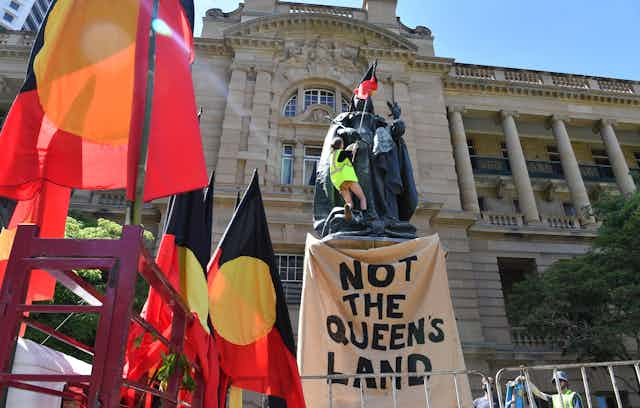After decades of calls, a patchwork of treaty processes are being developed across Australia. However, without a history of treaty-making or treaty law in Australia, serious questions arise about the best approach.
Getting treaties right is crucial for First Nations peoples’ well-being and for building a reflective, assured, and confident nation. This is urgent work, and yet the best way forward might involve working in longer time frames than is usual in policy reform.
Taking time with these processes is important because developing meaningful treaties requires negotiating political authority between Indigenous peoples and Australian governments, and the balance of power and resources between them.
Indigenous peoples have political authority going into treaty processes as the original peoples governing this continent for tens of thousands of years. However putting this authority into action is challenging because white Australian political forms and processes are pervasive.
In addition, many Aboriginal and Torres Strait Islander peoples have been systematically disconnected from their sources of authority and each other. This can make for challenging issues surrounding Indigenous representation in treaty processes.
Read more: A short history of the Aboriginal Tent Embassy – an indelible reminder of unceded sovereignty
Queensland’s approach
Victoria is acknowledged for being the first Australian state to begin developing a treaty, having passed the first legal framework for treaty negotiations. A treaty process has progressed relatively quickly since then.

Queensland began a “pathway” to treaty process in 2019. The Queensland government’s announcement of an open ended process as part of NAIDOC week was generally well-received at the time, but was no guarantee of success.
The Eminent Panel and the Treaty Advancement Committee have carefully listened to voices of First Nations communities and managed the complex politics involved with these consultations. The Queensland government has responded positively with a key next step to include the establishment of a “Treaty Institute” to invest in the state being treaty-ready over a ten year period.
Sustaining the Queensland approach
While the Queensland treaty process has thus far proceeded well, it stands at a crossroads as backroom negotiations to give shape to the Treaty Institute continue. Previous collaborative work in Indigenous-settler relations in Queensland suggests sustaining a meaningful treaty process requires following these three principles:
• the Treaty Institute needs to be as separate from government as possible and affirm the distinct political authority of Aboriginal and Torres Strait Islander peoples
• the Treaty Institute should focus on engaging with and supporting Indigenous peoples and their place-based forms of political authority, including to re-establish peer-to-peer treaties among Indigenous nations. (Existing Indigenous organisations have a role to play in this process but fresh, creative, and demanding work is also required)
• the governance and work of the Treaty Institute must be inclusive, recognising men’s and women’s law and their respective leadership as well as including the views of people of diverse ages, genders, sexualities, and abilities.
Navigating political authority and power
Developing meaningful treaties with First Nations peoples requires at least partly remedying the dominance of white Australian political forms and power. If this is not done it is not possible to negotiate political authority of First Nations peoples and Australian governments and the power relations between them.
Australian governments exercise sovereignty and have an abundance of power and resources, but they struggle with legitimacy and thus authority within treaty processes. As Professor of Law Irene Watson asks, “by what lawful authority do you … dispossess us?”
White Australia needs to grapple with the legitimacy of its claims to authority, including addressing past injustices and imbalance of power and resources in treaty processes.
Queensland’s proposed process allows time for the Queensland government to recognise Indigenous political authority while nurturing trust in the treaty process within Queensland’s diverse political communities.
The process is also broadly aligned with many First Nations peoples because of an affinity with continuity, a careful approach to change, and regard for protocol borne of tens of thousands of years of governing this continent. Additional time in these processes also allows space from immediate pressures of negotiating with government.
Most importantly, the proposed Treaty Institute provides Aboriginal and Torres Strait Islander peoples the necessary time and resources to consider how to preserve and strengthen Indigenous ideas and institutions in Australian policy and decision-making processes.
This can enable the pursuit of placed-based approaches to decision-making that draw on respective First Nations’ Countries.
As Australia’s treaty deliberations continue to develop, we will begin to see advantages and disadvantages of different approaches.
For now, the comparatively slower approach in Queensland looks to address fundamental challenges which could potentially be overlooked in a more rushed process.

